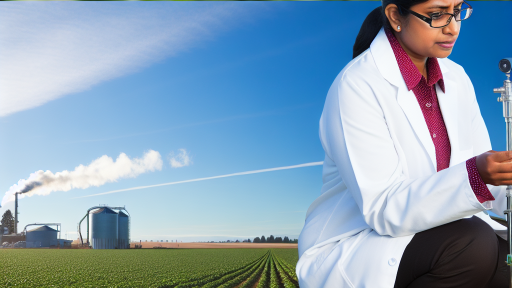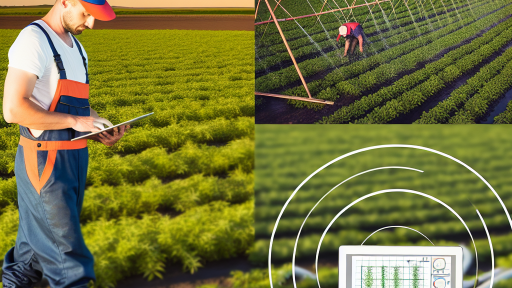Introduction to Carbon Sequestration
Carbon sequestration plays a vital role in agriculture today.
This process captures and stores carbon dioxide from the atmosphere.
Farms can significantly contribute to mitigating climate change.
By adopting carbon sequestration methods, farmers can enhance soil health.
Additionally, these methods can improve farm productivity.
Ultimately, effective sequestration practices benefit both crops and livestock.
Importance of Carbon Sequestration in Agriculture
Carbon sequestration is essential for sustainability in farming.
It helps reduce greenhouse gas emissions.
Furthermore, it combats soil depletion and erosion.
Healthy soils can store more carbon over time.
Consequently, this leads to improved agricultural outputs.
Farmers who adopt these methods often see long-term benefits.
Economic Benefits for Farmers
Integrating carbon sequestration practices can be financially advantageous.
Farmers may receive incentives for adopting sustainable practices.
Such incentives often come from government programs and organizations.
Transform Your Agribusiness
Unlock your farm's potential with expert advice tailored to your needs. Get actionable steps that drive real results.
Get StartedMoreover, farmers can enhance their marketability to eco-conscious consumers.
Thus, sustainable practices can lead to increased revenues.
Community and Environmental Impact
Carbon sequestration methods contribute positively to local communities.
They help maintain ecosystem balance by improving biodiversity.
By increasing carbon storage in soils, farms can support wildlife habitats.
Such practices also improve air and water quality in nearby areas.
Overall, farms engaging in carbon sequestration become community assets.
Overview of Different Carbon Sequestration Methods for Farms
Introduction to Carbon Sequestration
Carbon sequestration plays a crucial role in mitigating climate change.
This process captures and stores atmospheric carbon dioxide.
Farmers can implement various methods to enhance carbon storage in soils.
Soil Carbon Sequestration
Soil carbon sequestration involves increasing organic matter in the soil.
Cover cropping is an effective technique that prevents erosion.
Leguminous cover crops add nitrogen and boost soil health.
Furthermore, reduced tillage methods preserve soil structure.
This practice enhances carbon retention and microbial activity.
Use of Organic Amendments
Applying compost or manure significantly improves soil organic carbon levels.
These amendments provide nutrients while stimulating microbial activity.
They enhance the soil’s ability to store carbon for the long term.
Agricultural Practices
Farmers can adopt specific practices that promote carbon sequestration.
Crop rotation diversifies plant types and improves soil health.
Additionally, agroforestry combines crops with trees to increase biomass.
These practices enhance carbon capture and diversify farm production.
Integrating Livestock
Integrating livestock into cropping systems can optimize land use.
Managed grazing encourages plant regrowth and improves soil health.
Showcase Your Farming Business
Publish your professional farming services profile on our blog for a one-time fee of $200 and reach a dedicated audience of farmers and agribusiness owners.
Publish Your ProfileOverall, this method promotes a balanced ecosystem.
Bioenergy Cropping
Growing dedicated bioenergy crops can enhance carbon capture.
These crops, such as switchgrass, can provide renewable energy.
Through this method, farmers can generate income while sequestering carbon.
Perennial Crops
Perennial crops have extensive root systems that store carbon effectively.
They require less tillage and reduce soil disturbance.
This results in more stable carbon levels in farm soils.
Monitoring and Assessment
Farmers should regularly monitor soil carbon levels.
Utilizing technology can help assess the effectiveness of sequestration methods.
Tools such as soil sensors provide real-time data on carbon content.
Ultimately, this information helps farmers refine their practices.
Soil Management Practices
Enhancing Carbon Storage through No-Till Farming
No-till farming presents a viable solution for enhancing carbon storage.
This method reduces soil disturbance significantly.
Consequently, it preserves soil structure and organic matter.
Moreover, it prevents the release of carbon dioxide into the atmosphere.
An essential benefit of no-till practice is its impact on soil health.
It promotes healthy microorganisms that contribute to nutrient cycling.
These microorganisms thrive in undisturbed soils.
In turn, they enhance the soil’s capacity to store carbon.
Techniques to Implement No-Till Practices
Farmers can adopt several techniques for effective no-till farming.
- Use cover crops to protect and enrich the soil.
- Employ strip-tillage for better seed placement.
- Utilize specialized equipment for sowing without soil disturbance.
Cover crops play a crucial role in strengthening soil structure.
They prevent erosion while adding organic matter.
These practices collectively improve the soil’s ability to sequester carbon.
Challenges in No-Till Farming
While no-till farming offers numerous advantages, challenges exist.
For instance, farmers may struggle with weed management.
However, diverse cropping systems can help mitigate this issue.
Additionally, initial equipment costs may pose a barrier.
Despite these challenges, many farmers report long-term benefits.
These include improved yields and reduced fuel costs.
Case Studies of Successful Implementation
Successful case studies showcase the benefits of no-till farming.
For instance, Laura Jenkins from Green Valley Farms adopted this method.
She experienced a notable increase in soil carbon levels.
Furthermore, her crop yields improved significantly over time.
Similarly, the Roberts family in Sunny Acres transformed their farm.
After switching to no-till practices, they reported enhanced soil quality.
These examples demonstrate that no-till farming can lead to sustainable success.
Ultimately, effective carbon sequestration in farming requires commitment and innovation.
Gain More Insights: Benefits of Crop Rotation and Diversity in Farming
Cover Cropping: Benefits and Techniques for Carbon Sequestration
Enhancing Soil Health
Cover cropping significantly improves soil health.
These crops improve soil structure and increase organic matter.
Showcase Your Farming Business
Publish your professional farming services profile on our blog for a one-time fee of $200 and reach a dedicated audience of farmers and agribusiness owners.
Publish Your ProfileThis process enhances nutrient cycling and water retention.
Moreover, it leads to more resilient farming systems.
Carbon Sequestration Benefits
Cover crops capture atmospheric carbon dioxide effectively.
They store carbon in the soil, mitigating climate change impacts.
Additionally, they reduce soil erosion and nutrient leaching.
This can enhance long-term fertility and farm productivity.
Common Cover Crop Options
Farmers have various cover crop options to consider.
- Legumes, such as clover and vetch, add nitrogen to the soil.
- Brassicas, like radishes, improve soil structure and suppress weeds.
- Grasses, such as rye or oats, provide excellent biomass and cover.
Cover Cropping Techniques
Implementing cover cropping requires strategic planning.
Choosing the right species for the climate is crucial.
Farmers can also integrate cover crops into crop rotation schedules.
Moreover, consider planting cover crops during the off-season.
Best Practices for Success
To maximize benefits, follow these best practices.
- Inoculate legumes to boost nitrogen fixation.
- Terminate cover crops at the appropriate growth stage.
- Monitor soil health regularly to assess improvements.
Explore Further: Expert Pest Control Services in El Paso by Hirby Pest Control Since 1974
Agroforestry: Integrating Trees into Agricultural Landscapes
Defining Agroforestry
Agroforestry combines agriculture and forestry practices.
This method optimizes land use and enhances biodiversity.
It creates sustainable farming systems that benefit the environment.
Benefits of Agroforestry
Agroforestry offers numerous ecological and economic advantages.
- Improves soil health and fertility.
- Increases carbon sequestration capabilities.
- Enhances crop yields through improved microclimates.
- Provides habitats for diverse wildlife species.
Integrating Trees in Farms
Farmers can integrate trees into their landscapes in various ways.
Strip planting involves rows of trees between crop rows.
Silvopasture combines trees, forage, and livestock on the same land.
Alley cropping allows crops to grow between tree rows for dual benefits.
Choosing the Right Tree Species
Selecting appropriate tree species is critical for success.
Farmers should consider local climate and soil conditions.
Native species often provide the best ecological benefits.
Consulting with local forestry experts can guide proper selection.
Challenges in Implementation
Implementing agroforestry can present various challenges.
Initial labor and costs may deter some farmers.
Farmers must also adapt their management practices.
Long-term commitment and planning are vital for success.
Case Studies of Successful Agroforestry
Several farms have successfully adopted agroforestry systems.
The Johnson Family Farm in Wisconsin integrates maple trees with corn.
This method increases maple syrup production while boosting corn yields.
Similarly, the Patel Farm in California utilizes citrus trees with olives.
These combinations enhance biodiversity and provide income diversity.
Find Out More: Eco-Conscious Waste Solutions for Sustainable Farms
Crop Rotation and Diversification
Boosting Soil Carbon Levels
Crop rotation significantly enhances soil health.
This method involves alternating different crops in a sequence.
It breaks pest cycles and reduces soil depletion.
Moreover, diverse crops contribute varied organic matter.
Consequently, soil carbon levels increase over time.
Showcase Your Farming Business
Publish your professional farming services profile on our blog for a one-time fee of $200 and reach a dedicated audience of farmers and agribusiness owners.
Publish Your ProfileThe Role of Cover Crops
Cover crops play a crucial role in carbon sequestration.
Planting cover crops during off-seasons protects soil from erosion.
They also add organic matter when decomposed.
Common cover crops include clover, vetch, and rye.
These plants improve nitrogen levels in the soil.
Integrating Livestock into Crop Systems
Integrating livestock can enhance carbon sequestration efforts.
Managed grazing allows animals to naturally fertilize the land.
This practice increases soil organic matter significantly.
Moreover, crop residues provide food for livestock.
Thus, both systems support each other effectively.
Benefits of Crop Diversification
Diversifying crops mitigates risks associated with monoculture.
It enhances resilience against pests and diseases.
Additionally, diverse crop systems improve overall biodiversity.
This practice also allows farmers to tap into new markets.
As a result, they can stabilize their income sources.
Implementing Conservation Tillage
Conservation tillage is essential for maintaining soil carbon levels.
This method reduces soil disturbance during planting.
As such, it preserves soil structure and quality.
Moreover, it minimizes carbon loss from the soil.
Farmers benefit from reduced erosion and water retention improvements.
Monitoring and Assessment
Regular monitoring of soil health is fundamental.
Farmers should assess carbon levels periodically.
Utilizing soil testing can provide valuable insights.
Moreover, these assessments guide management practices.
With continual assessment, practices can be adapted as needed.
Explore Further: Sustainable Grazing Practices For Soil Care

Livestock Management: Reducing Emissions and Promoting Soil Health
Understanding the Impact of Livestock
Livestock farming significantly contributes to greenhouse gas emissions.
This includes methane emissions from enteric fermentation.
Additionally, manure management can lead to nitrous oxide release.
Therefore, effective livestock management is crucial for environmental sustainability.
Implementing Sustainable Practices
Adopting sustainable practices can help reduce emissions.
Rotational grazing is one effective method.
This technique enhances soil health and promotes carbon sequestration.
Moreover, it improves pasture productivity and reduces erosion.
Feeding Strategies
Feeding livestock a balanced diet can mitigate emissions.
High-quality forage decreases methane production during digestion.
Incorporating additives, such as seaweed, can reduce methane output.
Additionally, consistent feeding schedules improve overall livestock health.
Manure Management Techniques
Efficient manure management is vital for reducing emissions.
Composting manure helps to minimize greenhouse gases.
Showcase Your Farming Business
Publish your professional farming services profile on our blog for a one-time fee of $200 and reach a dedicated audience of farmers and agribusiness owners.
Publish Your ProfileFurthermore, applying manure as fertilizer enhances soil tilth.
This practice also increases carbon content in the soil.
Utilizing Agroforestry
Integrating trees into pasture systems aids in carbon sequestration.
Agroforestry provides shade and shelter for livestock.
Additionally, it improves biodiversity and soil health.
It creates a more resilient farming ecosystem overall.
Monitoring and Evaluation
Regularly monitoring livestock emissions is essential.
Evaluate practices to ensure they effectively reduce emissions.
Utilizing data analytics can enhance decision-making.
Consequently, this approach leads to continual improvement in management practices.
Innovative Technologies: Utilizing Carbon Capture and Storage in Farming
Methods of Carbon Sequestration
Carbon sequestration methods are crucial for reducing atmospheric carbon levels.
Farmers can implement various techniques to enhance soil carbon storage.
These methods range from improved land management to innovative technologies.
Soil Management Practices
Soil management practices play a significant role in carbon sequestration.
Incorporating cover crops can improve soil health and increase carbon storage.
Additionally, practicing reduced tillage helps to preserve soil structure.
Farmers can also benefit from crop rotation to diversify plant roots.
This variety promotes a more resilient and carbon-rich soil ecosystem.
Use of Biochar
Biochar is a promising tool for carbon sequestration in agriculture.
This stable form of carbon improves soil fertility and reduces emissions.
Farmers can produce biochar by pyrolyzing organic material.
Using biochar can enhance soil moisture retention and nutrient availability.
As a result, it supports healthier crops and contributes to carbon capture.
Precision Agriculture
Precision agriculture leverages technology for optimized farming practices.
Using data collection tools, farmers can monitor soil conditions effectively.
This approach allows for targeted interventions to improve soil carbon levels.
Farmers can adjust nutrient applications based on precise soil needs.
Consequently, this minimizes waste and enhances carbon retention.
Agroforestry Practices
Integrating trees into agricultural landscapes supports carbon capture.
Agroforestry provides additional biomass that stores carbon effectively.
This method also improves biodiversity and creates microclimates.
Moreover, it can lead to increased crop yields while enhancing the ecosystem.
Monitoring and Verification Technologies
Monitoring technologies are essential for measuring carbon sequestration outcomes.
Farmers can use remote sensing and soil sensors for accurate data collection.
These tools help verify the impact of carbon capture practices.
Consequently, they enable informed decision-making for future strategies.
Such verification supports farmers in achieving sustainability goals.
Policy and Incentives: Supporting Farmers in Implementing Carbon Sequestration Practices
Importance of Supportive Policies
Supportive policies are crucial for promoting carbon sequestration in farming.
They can significantly alter farmers’ decision-making processes.
Effective policies provide the necessary incentives for adoption.
Showcase Your Farming Business
Publish your professional farming services profile on our blog for a one-time fee of $200 and reach a dedicated audience of farmers and agribusiness owners.
Publish Your ProfileAdditionally, they create a favorable environment for innovation.
Incentives for Farmers
Financial incentives encourage farmers to adopt carbon sequestration practices.
Grants and subsidies can offset the costs of implementing these methods.
Moreover, tax breaks motivate farmers to integrate sustainable practices.
Market-based approaches can provide additional revenue streams.
Educational Programs and Resources
Education plays a vital role in adopting new farming techniques.
State and federal programs can offer training on best practices.
Workshops and seminars increase awareness of carbon sequestration benefits.
Creating resource networks helps farmers access information and tools.
Collaboration with Agricultural Organizations
Collaboration among various stakeholders enhances policy effectiveness.
Partnerships between government agencies and agricultural organizations are essential.
Such collaborations can lead to tailored solutions for local farmers.
Additionally, they foster knowledge sharing and resource pooling.
Monitoring and Evaluation
Monitoring the impact of policies is critical for continuous improvement.
Regular evaluations can identify successful practices and areas needing adjustment.
Stakeholder feedback should inform policy refinements.
Moreover, transparent reporting promotes accountability and trust.
Additional Resources
Regenerative Agriculture: Good for Soil Health, but Limited Potential …
Fact Sheet: Soil Carbon Sequestration | American University …




